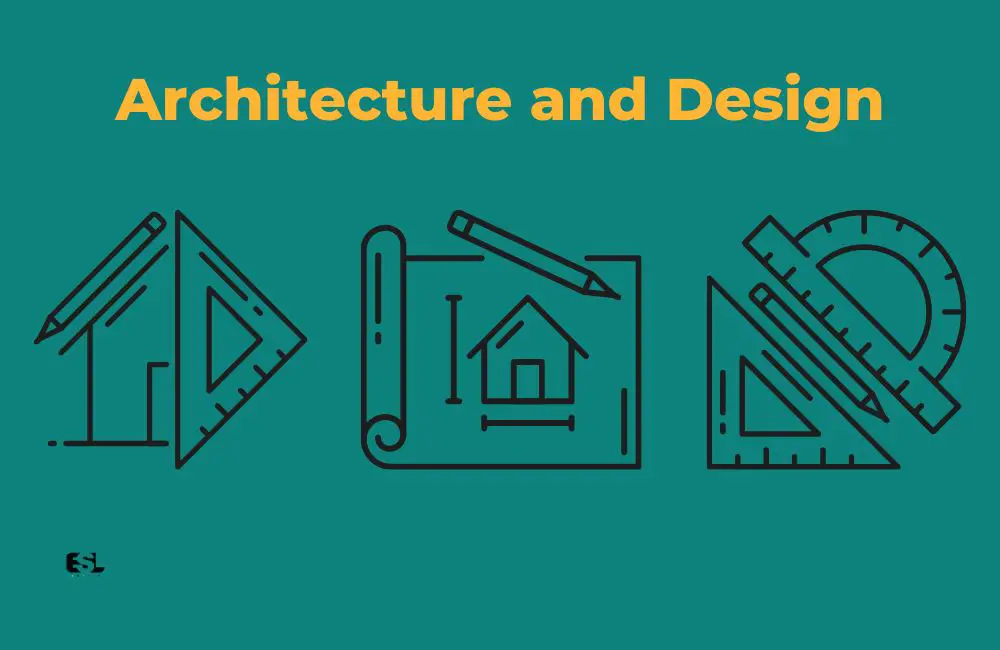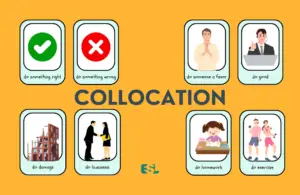Architecture and design is a diverse field that intertwines art, science, technology, and more. As such, it has a unique and complex set of terminologies that can be challenging for beginners to grasp. If you’re an aspiring architect, a design enthusiast, or simply someone interested in the aesthetics of the built environment around you, this article is for you.
Here, we’ll explore common architectural and design vocabulary to enhance your understanding and appreciation of these fields.
Table of Contents
- 1. Basic Architectural Concepts
- 2. Architectural Styles
- 3. Interior Design Terms
- 4. Sustainable Design Concepts
- Sample Conversation: Using Vocabulary Related to Architecture and Design
- Conclusion
- FAQ: Vocabulary Related to Architecture and Design
1. Basic Architectural Concepts
Let’s begin with some of the foundational terms and phrases in architecture.
| Word/Phrase | Meaning/Usage | Example Sentences |
|---|---|---|
| Facade | The front or principal face of a building | “The facade of the old cathedral was adorned with intricate carvings.” |
| Blueprint | A detailed plan or scheme | “The architect presented the blueprint of the proposed skyscraper.” |
| Floor Plan | A scaled diagram of a room or building viewed from above | “The floor plan showed the layout of the rooms.” |
| Elevation | A flat representation of one facade of a building | “The east elevation of the house featured large bay windows.” |
| Column | A vertical structural element that transmits the weight of the structure above to the structure below | “Greek architecture is known for its iconic columns.” |
| Beam | A long, sturdy piece of wood or metal across a building, supporting the structure | “The exposed wooden beams added a rustic charm to the house.” |
| Foundation | The lowest load-bearing part of a building | “A strong foundation is essential for the stability of a building.” |
| Facade | The front or principal face of a building | “The facade of the old cathedral was adorned with intricate carvings.” |
| Masonry | Stonework or brickwork | “The masonry on the old building has stood the test of time.” |
| Fenestration | The design, arrangement, and proportioning of windows in a building | “The fenestration in this design allows for plenty of natural light.” |
If you are searching for an effective English language vocabulary builder, try Word Power Made Easy: The Complete Handbook for Building a Superior Vocabulary (Amazon Link). This time-tested classic has helped millions achieve mastery of English and improve their communication skills in business, the classroom, and in life.
2. Architectural Styles
Different architectural styles tell the story of human history and culture. Here are some key phrases describing common architectural styles.
| Word/Phrase | Meaning/Usage | Example Sentences |
|---|---|---|
| Gothic Architecture | A style of architecture prevalent in Western Europe from the 12th to the 16th century, characterized by pointed arches, ribbed vaults, and flying buttresses | “The Notre-Dame Cathedral is a magnificent example of Gothic architecture.” |
| Brutalism | A style characterized by angular, block-like forms and raw concrete construction | “The brutalist architecture of the building gave it a minimalist, modern appeal.” |
| Renaissance Architecture | A style dating from the 14th to the 17th century, characterized by symmetry, proportion, and columns | “The Palazzo Medici is a classic example of Renaissance architecture.” |
| Art Deco | A design style of the 1920s and 1930s characterized by bold geometric shapes and strong colors | “The Chrysler Building in New York City is an iconic example of Art Deco architecture.” |
| Modernism | A style characterized by the use of modern materials (such as steel, glass, and concrete), open floor plans, and minimalist styling | “Modernism in architecture marked a break from traditional design principles.” |
| Postmodernism | A style characterized by a return to ornamentation, color, and environmental integration, often with a sense of humor and contradiction | “The Portland Building, with its colorful facade and abstract shapes, is a notable example of postmodern architecture.” |
| Neoclassical Architecture | A style characterized by grandeur, simplicity, and symmetry, drawing inspiration from the classical architecture of ancient Greece and Rome | “The White House is a notable example of Neoclassical architecture.” |
| Minimalist Architecture | A design style that uses pared-down design elements | “Minimalist architecture often utilizes simple geometric forms and monochromatic color schemes.” |
| Sustainable Architecture | Design approaches that minimize the negative environmental impact of buildings | “Sustainable architecture integrates renewable energy sources and maximizes natural light.” |
| Vernacular Architecture | A style of architecture which uses local materials and traditions to create buildings suited to their context | “Vernacular architecture in the Mediterranean often features white-washed walls and terracotta roofs.” |
3. Interior Design Terms
Moving inside, let’s look at some words commonly used in interior design and decor.
| Word/Phrase | Meaning/Usage | Example Sentences |
|---|---|---|
| Accent Wall | A wall whose design differs from the design of the other walls in the room | “The vibrant accent wall added a pop of color to the room.” |
| Feng Shui | An ancient Chinese practice of creating harmonious surroundings that enhance the balance of yin and yang | “She hired an expert to help improve the feng shui of her home.” |
| Minimalism | A style characterized by simplicity, functionality, and the use of minimal elements | “Her apartment showcased her love for minimalism.” |
| Vintage | Pertaining to or designating high-quality, classic or outmoded items, usually from the past | “The vintage rug added a unique charm to the room.” |
| Open-Plan | A floor plan in which one or more rooms form a large integrated space | “The open-plan kitchen and living room made the apartment feel more spacious.” |
| Aesthetics | A set of principles concerned with the nature and appreciation of beauty | “Her living room was praised for its aesthetics.” |
| Mood Board | A type of visual presentation or collage consisting of images, text, and samples of objects in a composition | “The interior designer created a mood board to showcase her ideas.” |
| Eclectic | Deriving ideas, style, or taste from a broad and diverse range of sources | “His home had an eclectic mix of modern and vintage pieces.” |
| Ambient Lighting | General, overall light that illuminates an entire room | “The room featured soft ambient lighting for a cozy feel.” |
| Contrast | The arrangement of opposite elements (light vs. dark colors, rough vs. smooth textures) in a piece so as to create visual interest | “The contrast between the modern furniture and rustic decor created an interesting visual dynamic.” |
4. Sustainable Design Concepts
Sustainability is becoming increasingly significant in architecture and design. Here are some terms related to this green movement.
| Word/Phrase | Meaning/Usage | Example Sentences |
|---|---|---|
| Passive Design | Design that takes advantage of the climate to maintain a comfortable temperature range in a home | “The architect incorporated passive design features to increase energy efficiency.” |
| Solar Panels | Panels designed to absorb the sun’s rays and convert them into electricity or heat | “The house was equipped with solar panels on the roof.” |
| Green Roof | A roof covered with vegetation and a growing medium, planted over a waterproofing membrane | “The building’s green roof helped reduce runoff and lower cooling costs.” |
| Rainwater Harvesting | The accumulation and storage of rainwater for reuse | “They installed a rainwater harvesting system to irrigate their garden.” |
| Insulation | The use of materials to reduce heat loss or gain by providing a barrier between areas that are significantly different in temperature | “Proper insulation can significantly reduce energy costs.” |
| Recycled Materials | Materials that have been processed and made into new products | “The house featured countertops made from recycled glass.” |
| Daylighting | The practice of placing windows or other openings and reflective surfaces so that natural light provides effective internal illumination during the day | “The architect used daylighting techniques to reduce the need for artificial lighting.” |
| Geothermal Energy | Heat energy generated and stored in the Earth | “The building uses a geothermal system for heating and cooling.” |
| Low VOC | Products that emit a minimal amount of volatile organic compounds (VOCs), which are harmful to the environment and human health | “The interior paint was low VOC to improve indoor air quality.” |
| LEED Certified | A building certification process developed by the U.S. Green Building Council (USGBC) to evaluate the environmental performance of a building and encourage sustainable design | “The commercial building was LEED certified, showcasing its commitment to sustainability.” |
To elevate your vocabulary in just 30 days, I recommend to my students an informative, fun, and accessible guide to utilizing powerful language. Millions of individuals have enhanced their academics, job skills, and confidence by dedicating just fifteen minutes daily to the exercises and tests of 30 Days to a More Powerful Vocabulary (Amazon Link), a top-selling. It offers step-by-step methods to bolster language prowess, discover compelling words, and daily vocabulary enhancement with pronunciation guidance.
Sample Conversation: Using Vocabulary Related to Architecture and Design
Situation: At a coffee shop, Jane, an architecture student, and Mark, an interior design enthusiast, discuss the blending of architecture and design in modern buildings.
Jane: Mark, I’ve been diving deep into modernism in architecture lately. The emphasis on function and the elimination of unnecessary detail is so appealing.
Mark: Absolutely, Jane. In interior design, we often draw inspiration from minimalism, which aligns well with modernist architectural concepts. The use of open floor plans and large glass facades creates such a seamless transition between the interior and exterior spaces.
Jane: True. And the integration of sustainable materials and green design principles not only makes structures eco-friendly but also aesthetically pleasing.
Mark: I couldn’t agree more. I’ve noticed many new buildings adopting vertical gardens and rainwater harvesting systems. Plus, with the emphasis on ergonomics, interiors are becoming more human-centered.
Jane: It’s all about balancing aesthetics with functionality. The blend of structural elements with design ensures that spaces are not just beautiful but also practical.
Conclusion
Understanding the language of architecture and design can enrich our appreciation for the built environment that surrounds us. These terms are just the tip of the iceberg when it comes to architectural vocabulary, but they offer a starting point for those eager to delve deeper into this fascinating field.
As you become more familiar with these terms and concepts, you’ll find yourself able to look at buildings and spaces with a more discerning and informed eye. Happy exploring!
FAQ: Vocabulary Related to Architecture and Design
1. What is modernism in architecture?
Modernism is a style in architecture that emerged in the first half of the 20th century. It emphasizes function, simplicity, and the elimination of superfluous details, often using new materials and technologies.
2. How does minimalism influence design?
Minimalism in design focuses on simplicity, using a limited color palette, clean lines, and uncluttered spaces. The idea is to create functional and serene spaces with only essential elements.
3. Why are open floor plans popular?
Open floor plans create a sense of spaciousness, allowing for flexible use of space and promoting social interaction. They offer better lighting and easier movement between different areas of a home or building.
4. What are the benefits of sustainable materials in architecture?
Sustainable materials are eco-friendly, reduce the carbon footprint, and often have a longer lifespan. Using them can lead to energy savings, lower maintenance costs, and a healthier living environment.
5. How does green design impact buildings?
Green design integrates environmental considerations into architecture and design. It focuses on energy efficiency, resource conservation, and creating healthy environments, often leading to cost savings in the long run.
6. Why is ergonomics essential in interior design?
Ergonomics ensures that spaces and furniture are designed with human well-being and comfort in mind. It considers posture, movement, and usability, enhancing the overall user experience.
7. What are vertical gardens?
Vertical gardens, or living walls, are gardens that grow vertically, often on walls or structures, allowing for green spaces in urban environments or areas with limited horizontal space.
8. How do rainwater harvesting systems work?
Rainwater harvesting systems collect and store rainwater for later use, reducing the reliance on municipal water supplies. This collected water can be used for gardening, flushing toilets, and sometimes even for drinking after purification.
9. How do structural elements influence design?
Structural elements, like beams, columns, and arches, provide the necessary support to buildings. In design, they can be highlighted or integrated creatively to enhance aesthetics and functionality.
10. What role does technology play in modern design?
Technology introduces innovative materials and construction techniques, allowing for more complex and efficient designs. Digital tools also enable precise planning, visualization, and even virtual tours before actual construction.






